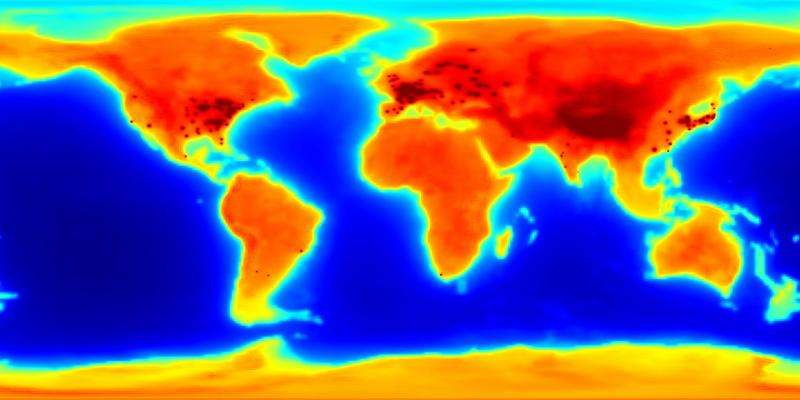First global antineutrino emission map highlights Earth's energy budget

The neutrino and its antimatter cousin, the antineutrino, are the tiniest subatomic particles known to science. These particles are byproducts of nuclear reactions within stars (including our sun), supernovae, black holes and human-made nuclear reactors. They also result from radioactive decay processes deep within the Earth, where radioactive heat and the heat left over from the planet's formation fuels plate tectonics, volcanoes and Earth's magnetic field.
Now, a team of geologists and physicists has generated the world's first global map of antineutrino emissions. The map, published online in the journal Scientific Reports on September 1, 2015, provides an important baseline image of the energy budget of Earth's interior and could help scientists monitor new and existing human-made sources of radiation. The study was led by the National Geospatial-Intelligence Agency with contributions from researchers at the University of Maryland, the University of Hawaii, Hawaii Pacific University and Ultralytics, LLC.
"The interior of Earth is quite difficult to see, even with modern technology. Locating the activity of antineutrinos allows us to create images that our predecessors had only dreamed of," said William McDonough, professor of geology at UMD and a co-author of the study. "This map should prove particularly useful for future studies of processes within the lower crust and mantle."
Neutrinos are notoriously difficult to study; their tiny size and lack of electrical charge enables them to pass straight through matter without reacting. At any given moment, trillions of neutrinos are passing through every structure and living thing on Earth. Luckily, antineutrinos are slightly easier to detect, through a process known as inverse beta decay. Spotting these reactions requires a huge detector the size of a small office building, housed about a mile underground to shield it from cosmic rays that could yield false positive results.
In the current study, the team analyzed data collected from two such detectors—one in Italy and one in Japan—to generate a picture of antineutrino emissions from natural sources deep within Earth. They combined this with data collected by the International Atomic Energy Agency (IAEA) on more than 400 operational nuclear reactors. In total, antineutrinos from these human-made sources accounted for less than 1 percent of the total detected.
"Keeping tabs on nuclear reactors is important for international safety and security. But as a geologist, I'm particularly excited for the potential to learn more about Earth's interior," McDonough said. "This project will allow us to access basic information about the planet's fuel budget across geologic time scales, and might yet reveal new and exciting details on the structure of the deep Earth."
The team plans to make periodic updates to the global antineutrino map in the future, with the help of improved models of Earth's interior and enhanced antineutrino detection technology. Updates to the map will also reflect the construction and decommission of nuclear reactors as appropriate. All told, the maps will provide an up-to-date picture of Earth's overall radioactivity.
"Antineutrinos are only one particle produced by Earth's natural radiation," explained Shawn Usman, R&D Scientist at the National Geospatial-Intelligence Agency and lead author of the study. "The National Geospatial-Intelligence Agency is working with UMD to develop additional radiation maps to characterize the Earth's naturally-occurring gamma and neutron radiation."
More information: The research paper, "AGM2015: Antineutrino Global Map 2015," Shawn Usman, Glenn Jocher, Stephen Dye, William McDonough and John Learned, was published online September 1, 2015 in the journal Scientific Reports. www.nature.com/articles/srep13945
Journal information: Scientific Reports
Provided by University of Maryland




















